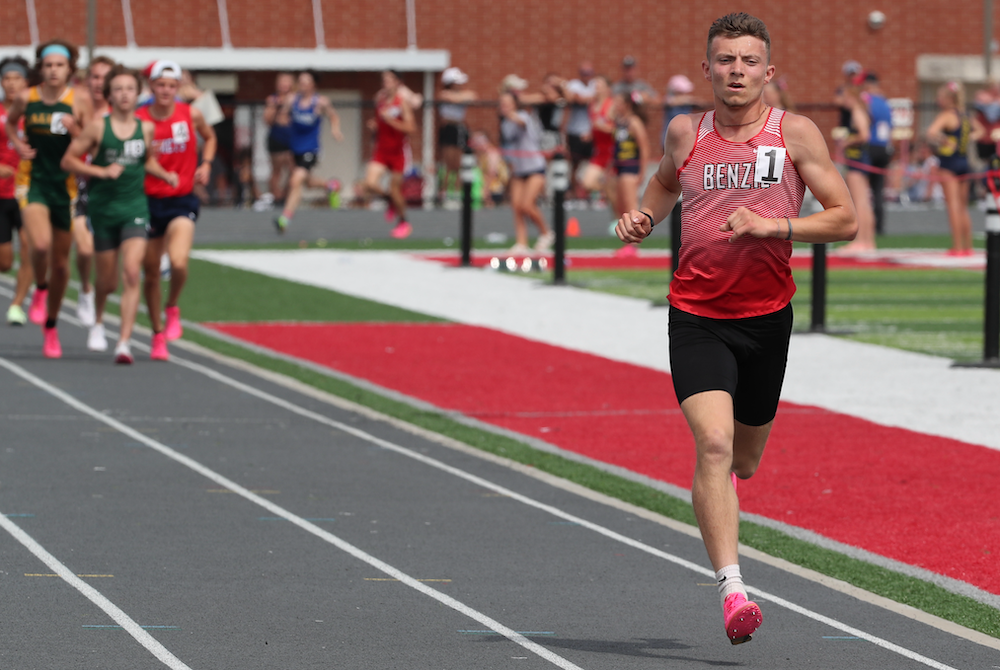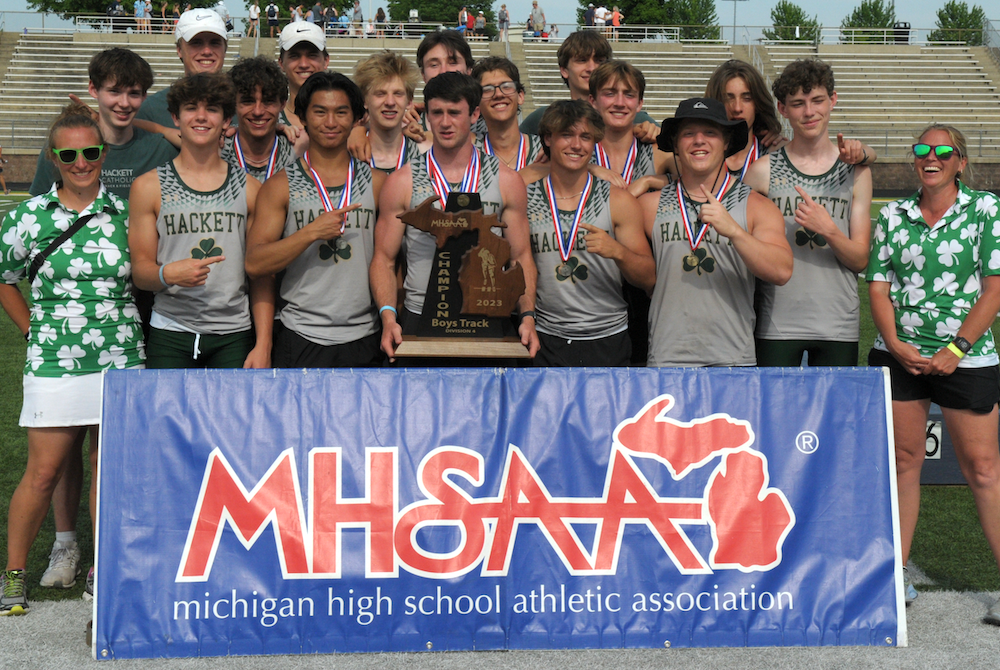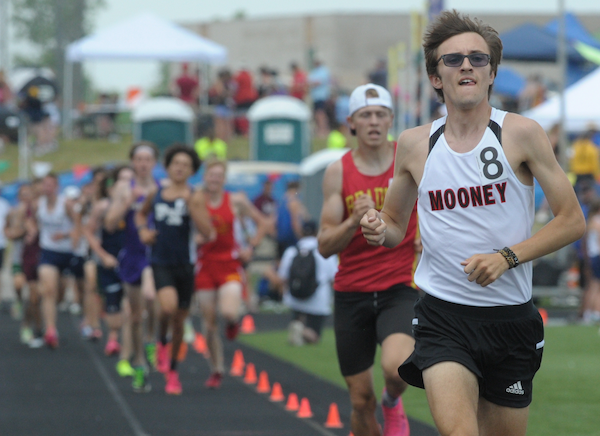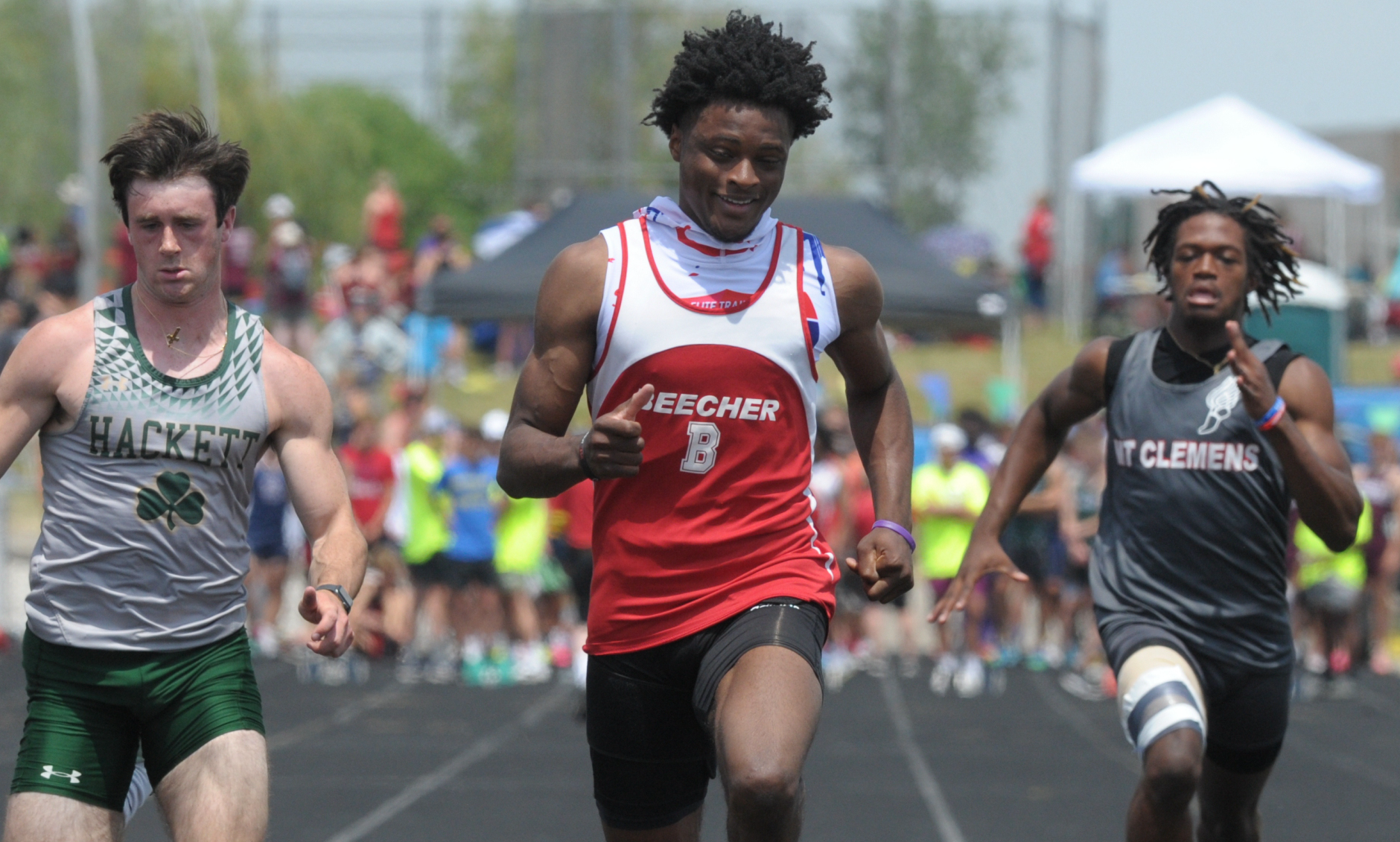
Jones Era Ends with 3 More Race Wins - But Better Yet, Benzie's 1st Team Title
By
Scott DeCamp
Special for MHSAA.com
June 4, 2023
KENT CITY – For four years of MHSAA cross country and track, Benzie Central’s boys runners and competitors alike have been trying to keep up with the Joneses.
Specifically, Benzie Central senior All-American Hunter Jones.
Well, Pol Molins lives with the Joneses (Hunter’s family) as a foreign-exchange student from Spain. Over the last few months, Molins has done a better job keeping up with Hunter Jones.
Now Jones, Molins and their Benzie Central teammates are all on the same level – as MHSAA Lower Peninsula Division 3 champions. The Huskies captured their first MHSAA Boys Track & Field Finals title, powered by Jones’ three individual championships along with strong efforts by Molins & Co. at Kent City High School.
Benzie Central totaled 51 points to hold off runner-up Pewamo-Westphalia, which tallied 44 points. Hart finished third (38), Sanford Meridian fourth (36) and Ottawa Lake Whiteford fifth (28).
“I’m very proud of myself, but ultimately my biggest goal today was to win a team state championship. We came out here, that’s what we did,” said Jones, a 6-foot, 160-pound Wake Forest signee, who cruised to victories Saturday in the 800-meter run (1:57.60), 1,600 run (4:17.48) and 3,200 (9:10.19).
Jones expressed much gratitude for not only Molins – who earned valuable points by taking second in the 1,600, fifth in the 3,200 and seventh in the 800 -- but for the other two runners on Benzie Central’s runner-up 3,200 relay team: Lucan Louwsma and Dorian Olson.
Benzie Central veteran coach Asa Kelly said Olson had never competed at Finals track meet before, and that this was the first time this foursome had run the 3,200.
“I really praise the 4x8 – those other two guys, they put us in the race and we got those eight points we needed,” Jones said. “If we didn’t run the 4x8, we would have lost. I thank those guys and I feel very blessed to finally get a team state championship. That’s been my biggest goal since I’ve gotten to Benzie.”
 That’s a big statement coming from a generational runner who closes his MHSAA career with 10 individual Finals championships: four in Division 3 cross country and six in track & field.
That’s a big statement coming from a generational runner who closes his MHSAA career with 10 individual Finals championships: four in Division 3 cross country and six in track & field.
Jones is a multiple-time national champion in various events as well as an indoor state champ numerous times. He holds MHSAA LP Division 3 Finals records in the 800 and 1,600, and he missed the Finals record in the 3,200 on Saturday by 1½ seconds.
After he learned Benzie Central had wrapped up the team title, he said he didn’t even care if he had won any events Saturday.
“It’s an overwhelming feeling, you know,” Jones said. “A couple of minutes ago, I was getting tears in my eyes and I was like, ‘It’s all over now.’ But I’m really happy that it ended with this and I couldn’t have asked for anything better. I’m very, very happy.”
There was plenty of joy to go around Saturday. North Muskegon junior Jerry Wiegers, who was making his Finals debut, raced to victories in the 200 and 400 with personal-record times in both. In the 200, he won with a time of 22.11 seconds. In the 400, he finished first with a time of 49.49.
Wiegers also anchored North Muskegon’s 800 relay team that placed seventh (1:32.44) for all-state honors.
“Yeah, I’m still processing it,” Wiegers said. “It’s just, like, a good feeling to have when all the work you put in through the whole year finally comes to a close out of everyone. I’ve been waiting to do this for a long time.”
It was a bit of a “bittersweet” day for Hart senior standout thrower Kellen Kimes. The Liberty University signee defended his Division 3 title in discus with a toss of 174 feet, 3 inches, but he came up just short in winning the shot put with a second-place toss of 57-¼.
It was the second-straight year Kimes finished runner-up in shot put, but the New Balance Indoor national champion in the weight throw was trying to keep proper perspective.
“I’m pretty sad that it’s over. I’ve got two more meets this year with the high school events, but from then on I’m going to be moving to college (competition),” Kimes said. “It’s easy to be, like, ‘OK, next chapter in my life,’ but I do need to spend some time reflecting on it and just realizing just how blessed I am with all the people that God’s put in my life.”
Kimes is a fierce competitor, but he’s always willing to help others, including his direct competition.
That was the case with Pewamo-Westphalia junior Gavin Nurenberg, who launched a personal record in shot put by two feet with an effort of 57-¼ that edged Kimes.
“I mean, it means a lot. It’s just, we were competitors – honestly, he taught me the most out of anybody in shot put,” Nurenberg said. “Like, this guy is telling me, get like certain cues and stuff and I do credit him for some of that for sure.”
Other champions Saturday included: Warren Michigan Collegiate’s Jailin Spikes in the 100 (10.71 PR), Napoleon’s Holden Van Poppel in the 110 hurdles (14.48 PR), Delton Kellogg’s Torren Mapes in the 300 hurdles (40.01 PR), Meridian’s Sawyer Moloy in high jump (6-4), Ovid-Elsie’s Tryce Tokar in pole vault (15-0), Grayling’s Mitchel Harrington in long jump (22-1.75), Meridian’s 400 relay (Kenneth Emmerson, Madix Saunders, Nickolas Metzer and Brayden Riley; 43.47), Burton Atherton’s 800 relay (Romiel Clausell, Joseph Embury, Jaymes Vines, Patrick Rice; 1:30.51), Whiteford’s 1,600 relay (Shea Ruddy, Ryin Ruddy, Dylan Anderson, Jacob Iott; 3:27.28), and Hart’s 3,200 relay (Clayton Ackley, Seth Ackley, Guillermo Ortega, Wyatt Dean; 8:04.54). Grosse Pointe Woods University Liggett junior Jake Juip won the adaptive 100 race (1:04.21), and Perry junior Alec Chapman competed in the adaptive shot put (3-8¼).
Benzie Central was the Division 3 runner-up in 2021 and 2001. This time, the Huskies got over the hump.
Dominant as Jones was, Molins provided quite the boost in the way of quality depth.
“It’s crazy with Pol (when he applied to be an exchange student) – they said he liked to run and he checked off track & field as an interest, but can’t find anything else about the kid,” Kelly said with a smile. “… In cross, he was maybe like 23rd (in the state) or something like that, but then over the course of the winter running every day with Hunter, he just exploded.”
Kelly said that Molins will head back to Spain in a few weeks and he’ll race in the Spanish U18 Nationals. Kelly noted that after this season with Benzie Central, Molins is ranked second in Spain for his division in the 1,500 and 800.
Molins, a sophomore who recently turned 16 years old, said he could not have asked for a better experience or better host family than the Joneses.
“They’ve pushed me in every way,” he said. “I’ve learned lots of stuff, a lot of discipline. I’ve worked a lot, put in a lot of miles. All of this, I’m going to take it to Spain. I’m going to get better and if I can, I’m going to come back in a couple of years for college. It would be great.
“I’m really grateful,” added the lanky, 6-foot-3 Molins. “l couldn’t have asked for a better experience. I’m looking forward to coming back one day and checking on everyone, how they are doing.”
(PHOTOS) Benzie Central’s Hunter Jones, far right, leads one of his races by a significant margin Saturday at Kent City. (Middle) Teammate Pol Molins, second from right and leading the rest of the field, follow Jones. (Photos by Carter Sherline/RunMichigan.com.)

Thrower Claims Lone Individual Title to Lead Hackett to Team 3-Peat
By
Tom Lang
Special for MHSAA.com
June 3, 2023
Kalamazoo Hackett Catholic Prep just keeps winning and winning.
This time the Irish took home their fourth title in the last five Lower Peninsula Division 4 Track & Field Finals, on Saturday at Hudsonville.
Hackett’s only individual title was taken by discus winner Nathan Buchmann, a senior, who was fine knowing he was the shortest in stature among all the sizable competitors.
“In the offseason after football I worked out every day, working towards this goal,” he said after getting his medal. “I would say this takes 80 percent technique and 20 percent strength to throw the discus. So, length can help but if you have good technique and are really strong, that will play into it.
“I think we are very balanced throughout the meet today,” he said about teammates that scored points in finishes other than first place. “We have 13 guys here today, and we have people in a lot of the races. But I do not run; I have too short of legs to be a fast runner,” he said with a chuckle.
Buchmann had to work through a hip injury to compete this spring.
“I think the setbacks are what make you strong,” he said. “You can either give up through the setbacks or push forward and become better.”
 Coach Charissa Dean agreed.
Coach Charissa Dean agreed.
“The kids have big hearts,” she said after all the points were totaled and the Irish were on top once again, with 53. “They worked hard. They had a lot of potential when we started the season. And we had a lot of drive to put in the work, and we are happy the results came out the way they did.”
Reading was runner-up at 47 points, followed by Wyoming Potter’s House Christian with 42, then Fowler and Flint Beecher each with 37 points.
Senior Lezawe “Moses” Osterink, of Potter’s House Christian, placed second in 1,600 but took the 3,200 title as defending champ of both. He dominated the latter by lapping the field with a final lap kick that resembled more of a superhero speedster.
“Nobody really took it out that hard at the start,” he said. “There was a freshman (Marek Butkiewicz of Hackett) that tried to get the pace going quick, but me and Dakota (Dykhuis of Montabella) just kind of sat back and gradually pulled him through.
“We took it gradually, and I was just relying that I could kick.”
Kick did he ever. The trio were neck and neck the majority of the race in a grouping ahead of the pack.
“With 400 to go I just tried to go all out,” Osterink said. “I had a lot more left than I thought and I was pleased with the win. Not really the time, but that doesn’t matter, especially this hot out.”
The overall meet was in the low 90s/high 80s heat and searing sun all day. So, race officials allowed the unique opportunity for coaches to spray the runners with water and give them water bottles.
“It was very weird because I’ve never taken water to drink while I’m running, so I didn’t know how that would feel,” Osterink said. “And they were spraying us and hitting us in the face. It was kind of fun.”
Junior Tyler Lenn of Marine City Cardinal Mooney defeated Osterink at his own game in the 1,600.
“I’m feeling great,” Lenn said after grabbing the medal. “I said to a newspaper after one of my races (during the season) I was right where I wanted to be. This has been a long rebuilding process for me since an injury back in the fall, and I set a pretty high goal the day the injury happened. I was telling myself I needed to fulfill what I said I would do at the beginning of last cross country season. And that is what I did today.”
Lenn suffered an ankle sprain from a misstep that turned worse because he kept running through the season on it.
“Coming back from that was pretty tough, but I wouldn’t have it any other way,” he said.  “Perseverance; I said from the beginning what I was going to do. I kept my eye on that target, and no matter the circumstances life threw at me, that I was going to make it happen and I am a man of my word.”
“Perseverance; I said from the beginning what I was going to do. I kept my eye on that target, and no matter the circumstances life threw at me, that I was going to make it happen and I am a man of my word.”
Jaylin Townsend, a senior from Flint Beecher, dominated the short races. He won the 100 dash (10.67) and 200 dash at 22 seconds flat. It was his third 100 win at a Finals.
“I put in a lot of work; I had to three-peat,” he said after the 100. “There’s a lot of great competition here, so I knew I had to come out and run my best.”
Concord in the 400 (43.72), Buckley in the 800 (1:30.76) and 1,600 (3:29.13) and Potter’s House in the 3,200 (8:14.18) were relay champs Saturday. Reading’s Tayshawn Bester won the 110 hurdles (15.13), and Athens’ Landen Bennett won the 300 (39.85). Caseville’s Nathan Feltner won the 400 (50.76), and Vestaburg’s Owen Patton claimed the 800 (1:55.11).
Fruitport Calvary Christian’s Bradley Richards won the high jump (6-10), and Peck’s Alex Affer won the long jump (23-4). McBain Northern Michigan Christian’s Isaac Bowden was first in pole vault (13-0), and Brown City’s Kyle Affer won shot put (49-2).
PHOTOS (Top) Kalamazoo Hackett Catholic Prep celebrates its third-straight LPD4 title Saturday. (Middle) Cardinal Mooney's Tyler Lenn, far right, sets the pace in the 1,600. (Below) Flint Beecher's Jaylin Townsend, middle, crosses the finish first for one of his two sprint championships. (Photos by Ken Swart/RunMichigan.com.)

